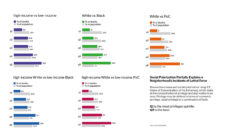Beginning in the 1930s, redlining prevented African Americans from purchasing homes in suburban areas primarily occupied by Whites. At the same time, residents of predominantly Black neighborhoods were denied business loans and capital that could have promoted well-paying jobs, affordable housing, and highly-rated schools. While the practice of redlining is now illegal, the consequences of the resultant segregation are still felt today.
A recent report by the Robert Wood Johnson Foundation found that Black residents remain more affected by segregation than White residents. As illustrated by the graph above, Black children in counties with high segregation (indicated by the light blue columns) experienced worse poverty, infant mortality, and high school graduation rates than those in less segregated counties (dark blue columns).
On the other hand, White residents were less affected by residential segregation. For White residents, child poverty and high school graduation rates were comparable in counties with high or low racial segregation.
Residential segregation worsens health for Black Americans. This link between race, place, and health is in large part the result of a history of unequal access to opportunity in the US—a history of policies and practices that gave access to White Americans and systematically denied it to Black Americans.
Addressing health inequities caused by residential segregation requires initiatives that are localized, multisectoral, and equity-oriented. Organizations like Purpose Built Communities have successfully employed this approach in community revitalization projects across the country.
Databyte via University of Wisconsin Population Health Institute. County Health Rankings Key Findings 2018.














